Loss of integ Study guides, Class notes & Summaries
Looking for the best study guides, study notes and summaries about Loss of integ? On this page you'll find 48 study documents about Loss of integ.
All 48 results
Sort by
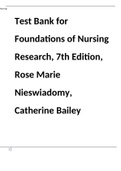
-
Test Bank for Foundations of Nursing Research, 7th Edition, Rose Marie Nieswiadomy, Catherine Bailey
- Exam (elaborations) • 203 pages • 2022
-
- $15.49
- 2x sold
- + learn more
Test Bank for Foundations of Nursing Research, 7th Edition, Rose Marie Nieswiadomy, Catherine Bailey Table of contents 1. Development Of Nursing Research 2. Evidence-Based Nursing Practice 3. Research Evidence In Nursing Practice 4. Ethical Issues In Nursing Research 5. An Overview Of Quantitative And Qualitative Research 6. Identifying Nursing Research Problems 7. Review Of The Literature 8. Theory And Nursing Research 9. Hypotheses 10. Quantitative Research Desi...

-
Gerontological Nursing, 4e (Tabloski) Chapter 18 The Musculoskeletal System
- Exam (elaborations) • 17 pages • 2024
-
- $10.99
- + learn more
Gerontological Nursing, 4e (Tabloski) Chapter 18 The Musculoskeletal System 1) After assessing an older patient, which musculoskeletal changes will the nurse attribute as being a normal part of the aging process? Select all that apply. 1. Loss in height 2. Lower leg muscle atrophy 3. Calcification of the finger joints 4. Swan neck deformity of the hands 5. Decreased range of motion in the shoulders Answer: 1, 2, 5 Explanation: 1. A change in the musculoskeletal status tha...
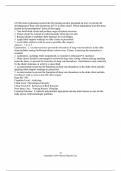
-
Gerontological Nursing, 4e (Tabloski) Chapter 21 The Hematologic System
- Exam (elaborations) • 23 pages • 2024
-
- $10.99
- + learn more
Gerontological Nursing, 4e (Tabloski) Chapter 21 The Hematologic System 1) Which clinical finding by the nurse is considered normal in the older adult client? 1. A hemoglobin of 10 g/dL two days post-joint replacement 2. Reports of the hands and feet feeling extremely warm 3. Skin tear with bruising, re-bleeding, and prolonged healing time 4. Poor or weak pulse amplitude in bilateral lower extremities Answer: 1 Explanation: 1. Red blood cell reserve and replacement is slower ...
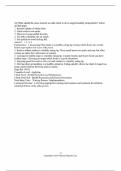
-
Gerontological Nursing, 4e (Tabloski) Chapter 5 Nutrition and Aging
- Exam (elaborations) • 19 pages • 2024
-
- $10.49
- + learn more
Gerontological Nursing, 4e (Tabloski) Chapter 5 Nutrition and Aging 1) The nurse is discussing proper nutrition with older community members at a senior citizen center. What should the nurse teach as general guidelines for healthy older individuals? Select all that apply. 1. Calcium intake should be 1,000 mg for those over the age of 51 years. 2. Older individuals need to take supplements of vitamins A, C, E, and K. 3. Vitamin D intake should be 600 IU up to age 70 and 800 IU if ...

-
Gerontological Nursing, 4e (Tabloski) Chapter 7 Psychological and Cognitive Function
- Exam (elaborations) • 13 pages • 2024
-
- $10.99
- + learn more
Gerontological Nursing, 4e (Tabloski) Chapter 7 Psychological and Cognitive Function 1) During an interview, the nurse notes that an older patient is having mild difficulty with some words and forgets the names of people. The patient is alert, oriented to time, person, and place, and makes appropriate responses. What does the nurse determine this patient's cognitive changes to mean? 1. Normal signs of aging 2. Early symptoms of dementia 3. Indicators of depression in the elder...
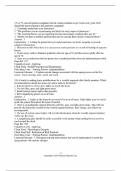
-
Gerontological Nursing, 4e (Tabloski) Chapter 14 Sensation: Hearing, Vision, Taste, Touch, and Smell
- Exam (elaborations) • 16 pages • 2024
-
- $10.49
- + learn more
Gerontological Nursing, 4e (Tabloski) Chapter 14 Sensation: Hearing, Vision, Taste, Touch, and Smell 1) The nurse is performing a vision assessment on an older patient who is having difficulty reading small print. What best explains this finding? 1. Non-reactive to light 2. Weak eye muscles 3. Lack of peripheral vision 4. Altered accommodation Answer: 4 Explanation: 1. Sensitivity to light is caused by an inability of the pupil to adapt to varying degrees of light. 2. D...
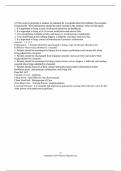
-
Gerontological Nursing, 4e (Tabloski) Chapter 24 Caring for Frail Elders with Comorbidities
- Exam (elaborations) • 21 pages • 2024
-
- $10.49
- + learn more
Gerontological Nursing, 4e (Tabloski) Chapter 24 Caring for Frail Elders with Comorbidities 1) The nurse is assessing an older patient in a skilled facility for frailty. During the assessment, the nurse determines frailty through the presence of which characteristics? Select all that apply. 1. Unplanned weight gain 2. Poor endurance 3. Increase in grip strength 4. Low activity tolerance 5. Generalized weakness Answer: 2, 4, 5 Explanation: 1. Frailty has also been defined ...
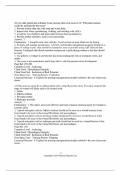
-
Gerontological Nursing, 4e (Tabloski) Chapter 12 The Integument
- Exam (elaborations) • 14 pages • 2024
-
- $10.99
- + learn more
Gerontological Nursing, 4e (Tabloski) Chapter 12 The Integument 1) An older patient has a subnormal body temperature and an infection. How does the nurse best describe this phenomenon? 1. The temperature regulating mechanism deteriorates with aging. 2. The patient's infection is improving with medication treatment. 3. The diagnosis of an infection is inaccurate and will be checked. 4. The temperature was obtained incorrectly and is inaccurate. Answer: 1 Explanation: 1. An ...
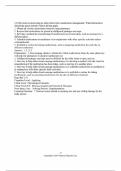
-
Gerontological Nursing, 4e (Tabloski) Chapter 6 Pharmacology and Older Adults
- Exam (elaborations) • 20 pages • 2024
-
- $10.99
- + learn more
Gerontological Nursing, 4e (Tabloski) Chapter 6 Pharmacology and Older Adults 1) An older client being treated for pneumonia is given a sedative to sleep. A few hours afterwards, the client has a respiratory rate of 12 and cannot be aroused. What does this assessment finding indicate to the nurse? 1. The sedative was not absorbed. 2. The sedative has reached a therapeutic blood level. 3. The medication for sleep caused excessive sedation. 4. The client is experiencing complicat...
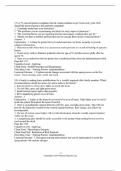
-
Gerontological Nursing, 4e (Tabloski) Chapter 14 Sensation: Hearing, Vision, Taste, Touch, and Smell
- Exam (elaborations) • 16 pages • 2024
-
- $10.49
- + learn more
Gerontological Nursing, 4e (Tabloski) Chapter 14 Sensation: Hearing, Vision, Taste, Touch, and Smell 1) The nurse is performing a vision assessment on an older patient who is having difficulty reading small print. What best explains this finding? 1. Non-reactive to light 2. Weak eye muscles 3. Lack of peripheral vision 4. Altered accommodation Answer: 4 Explanation: 1. Sensitivity to light is caused by an inability of the pupil to adapt to varying degrees of light. 2. D...

That summary you just bought made someone very happy. Also get paid weekly? Sell your study resources on Stuvia! Discover all about earning on Stuvia


